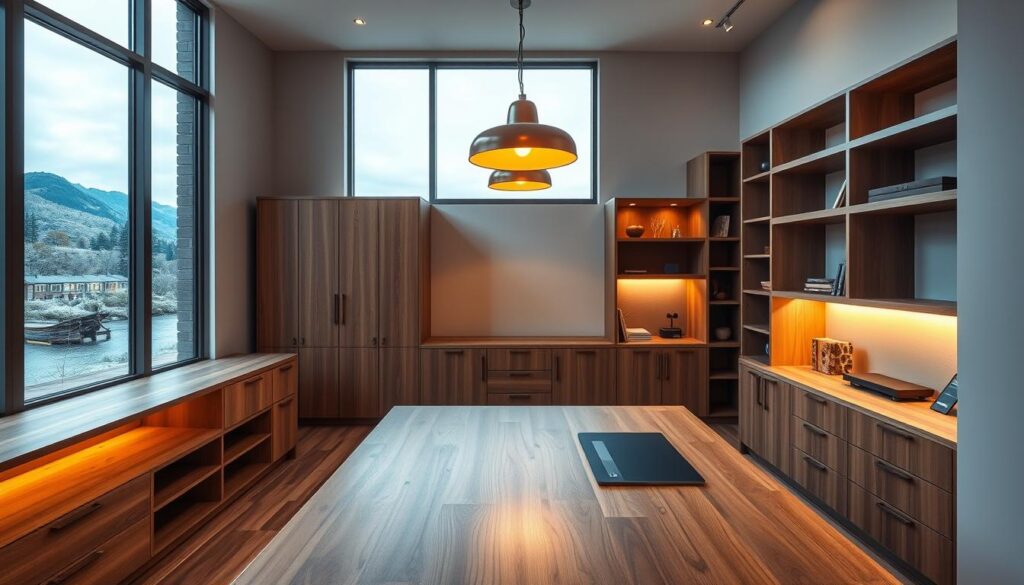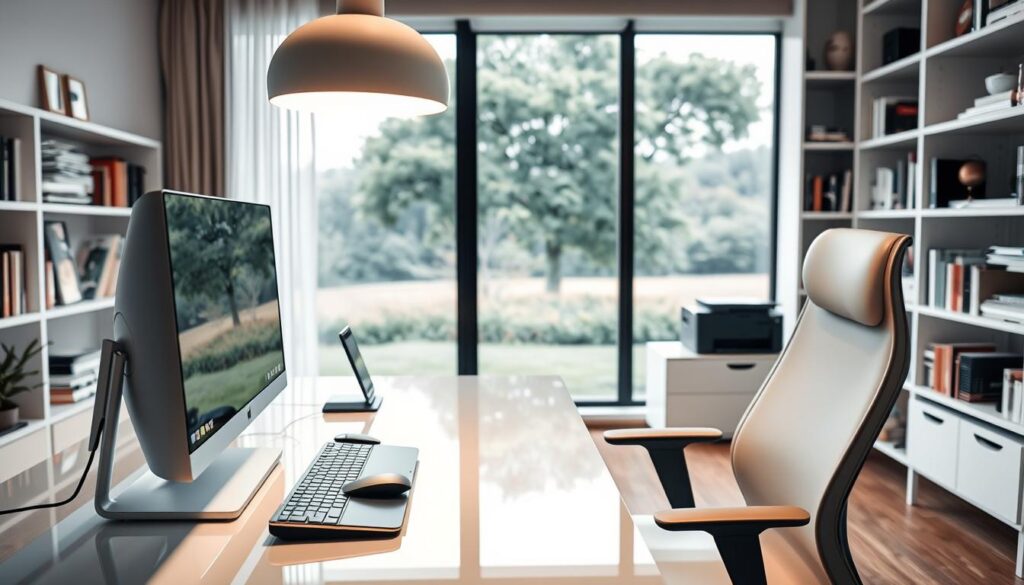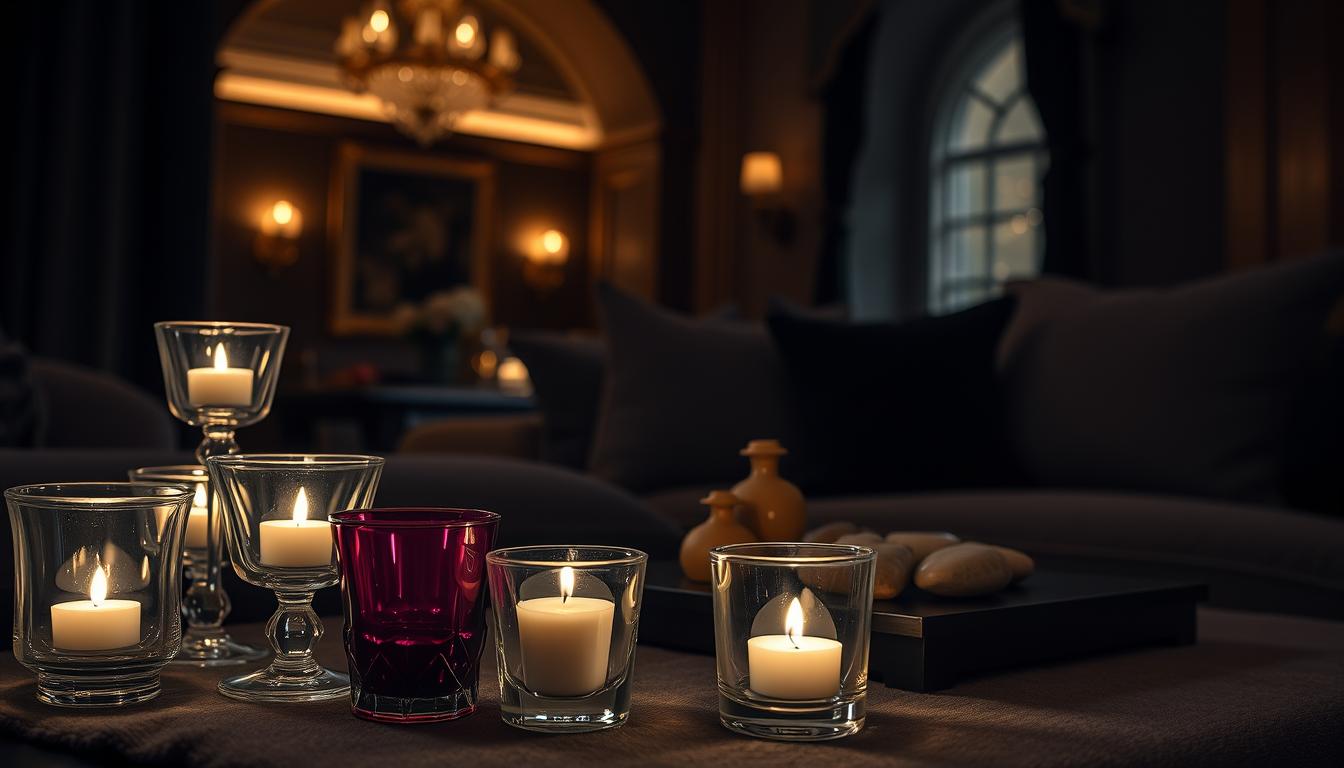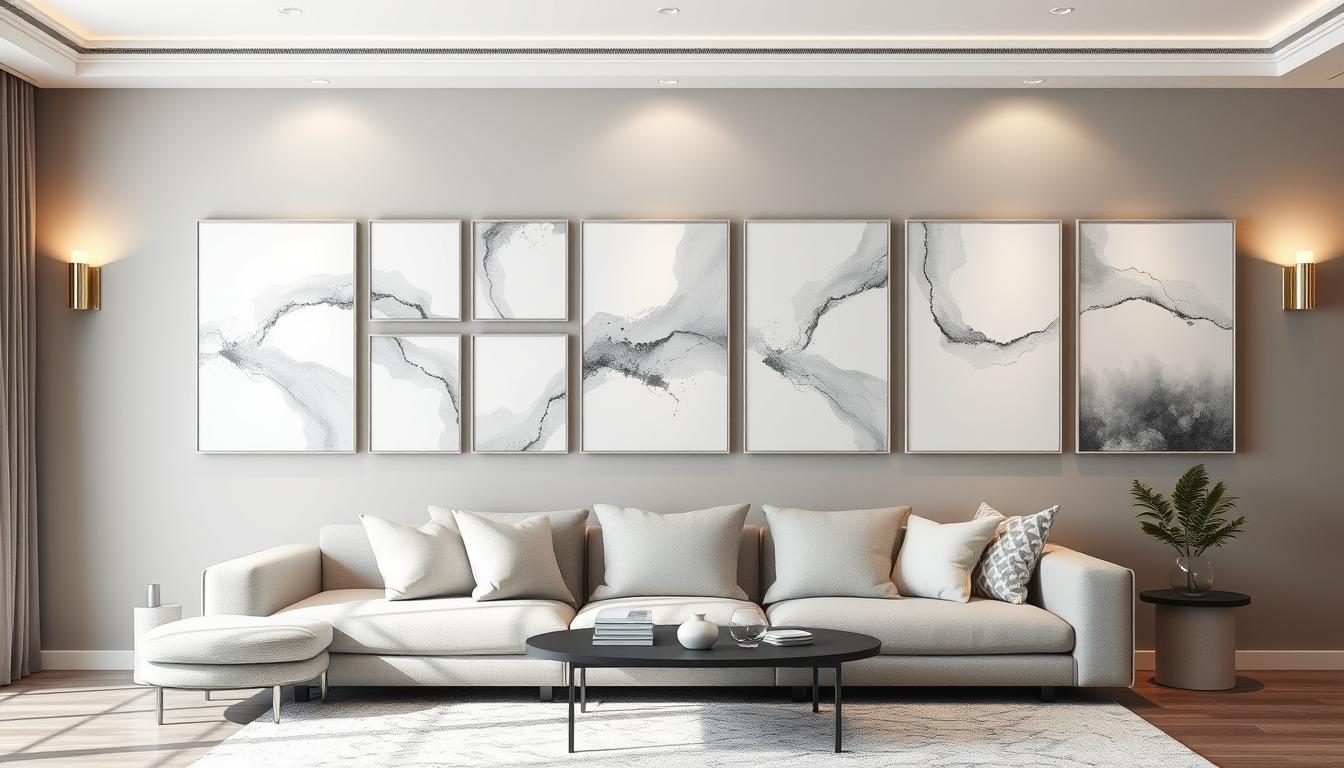More people work from home than ever before. This makes having a good home office key for staying productive and balanced. A well-designed space helps you focus and work better.
We’ll look at how interior decorating makes a workspace better. You’ll get tips and ideas to make your home office both stylish and efficient.
Key Takeaways
- Create a dedicated workspace to boost productivity
- Choose a comfortable and ergonomic chair
- Use lighting to enhance the ambiance and functionality
- Incorporate storage solutions to maintain organization
- Select a color scheme that promotes focus and creativity
Understanding the Importance of a Well-Designed Home Office
A well-designed home office is more than a place to work. It boosts productivity and creativity. With more time working from home, having a good workspace is key.
Our surroundings greatly affect our work efficiency and happiness. A well-thought-out home office can make a big difference. We’ll look at what makes a home office effective.
Enhancing Productivity
A well-designed home office boosts our productivity. By using effective office design ideas, we can focus better. This includes:
- Minimizing distractions
- Optimizing the layout for workflow
- Incorporating elements that stimulate creativity
For more ideas on a productive home office, check out our article on crafting the perfect home office. It offers great interior design tips.
Creating a Comfortable Space
Comfort is key in a home office. An ergonomic setup and comfy seating reduce fatigue. Home office organization helps by keeping things within reach.
For a comfy home office, consider:
- Ergonomic furniture
- Adequate lighting
- A clutter-free environment
Reflecting Personal Style
Our home office should show our personal style. This makes the space more enjoyable and boosts creativity. By using interior design tips that match our taste, we make the space our own.
Personalizing our home office can be done by:
- Adding decorative elements that reflect our personality
- Incorporating colors that inspire us
- Displaying personal achievements and inspirations
Assessing Your Available Space
Understanding your available space is key to a good home office. To begin your home office makeover, know the room’s layout and size. This is your work from home space.
Measuring Your Room
Start by measuring the room’s length, width, and any obstacles. This includes heating vents, outlets, or windows. Use a tape measure for accurate sizes. You can also draw a floor plan on paper or use a digital tool.
Remember to note the location of doors and windows. They affect where you can place furniture. For example, put your desk near a window for natural light.
Identifying Key Areas for Work
After measuring, find the main work areas. Think about the tasks you’ll do in your office. You might need a computer area, a reading spot, or storage for supplies.
Plan the flow of your workspace. You should be able to move easily without feeling cramped. Use multi-functional furniture in small spaces to save room.
Considering Natural Light
Natural light is vital for any workspace. It cuts down on artificial lighting and boosts mood and productivity. Think about how much natural light your space gets.
Place your main workspace near a window if you can. But watch out for glare on your screen. Use curtains or blinds to control the light. For less light, add the right lighting to make your space bright and inviting.
By measuring your room, finding key work areas, and thinking about light, you can make a work from home space that works well. This is the first step to a successful home office makeover.
Selecting the Right Color Palette
Choosing the right color palette is key for a home office that looks good and works well. The colors you pick can really affect your mood and how productive you are.
The Impact of Colors on Mood
Colors deeply affect our feelings and can either energize or calm us. For example, blue tones help us feel calm and trustful. Yellow boosts creativity and energy. Knowing how colors affect us can help you create a space that supports your well-being and work style.
Here are some common colors and their effects:
- Red: Stimulates energy and alertness
- Green: Enhances balance and growth
- Purple: Fosters creativity and luxury
- Neutral tones: Promotes calmness and simplicity
Choosing Colors for Different Tasks
Different tasks need different environments. For creative work, a bright color scheme might be good. But for tasks that need focus, a calmer palette is better.
Consider these tips when choosing colors for different tasks:
- Identify the main tasks you do in your home office
- Pick colors that match the mood you want for those tasks
- Test the colors with different lights to see how they look all day
Incorporating Accent Colors
Accent colors add depth and personality to your office. They can be in furniture, decor, or accessories to make your space more interesting.
To use accent colors well:
- Pick accent colors that go with your main colors
- Use them a bit to avoid too much color
- Follow the 60-30-10 rule: 60% main color, 30% secondary, and 10% accent
By picking your colors carefully and adding accent colors thoughtfully, you can make a home office that’s stylish and productive. For more interior design tips, check out resources focused on office decor and design.
Choosing Functional Furniture
Choosing the right furniture for your home office is key to being productive and comfortable. Good furniture makes your home office work better. It helps you work well and feel good.
Desks That Suit Your Style and Needs
Your desk is the heart of your home office. It’s important to pick one that fits your space, work style, and taste.
- Corner desks are great for small rooms.
- Standing desks are good for your health and work.
- Traditional desks offer a classic look and lots of space.
Ergonomic Seating Options
Good seating is key for comfort and health. Look for chairs with back support, height adjustment, and armrests.
Key Features of Ergonomic Chairs:
| Feature | Description | Benefit |
|---|---|---|
| Lumbar Support | Adjustable to fit your lower back. | Less strain on your back. |
| Adjustable Height | Customizes to your body. | Better posture and less eye strain. |
| Armrests | Supports your arms while working. | Less strain on shoulders and neck. |
Storage Solutions for a Clutter-Free Workspace
Good storage keeps your workspace tidy and organized. Use filing cabinets, shelves, and desk organizers.

With the right desk, chair, and storage, your home office will be both useful and cozy. This makes you more productive and happy at work.
Lighting Considerations
A good lighting system can make your home office feel better and work better. It’s not just about light; it’s about making a space that’s comfy and productive.
Combining Natural and Artificial Light
Natural light is great for a home office because it makes you feel better and work better. But, you can’t always get enough of it. That’s why you need artificial light too. To get more natural light, put your desk near a window. Use LED bulbs for artificial light because they save energy and look good.
Task Lighting vs. Ambient Lighting
Task lighting shines on specific areas, like your desk. Ambient lighting lights up the whole room. Using both is key for a good home office. Task lighting eases eye strain, and ambient lighting makes the room feel friendly.
Adjustable Lighting Solutions
Lighting that you can adjust, like dimmable LED lights or smart systems, lets you change the light for different tasks or times. This makes your work space more comfy and productive.
Here’s how different lights can work together in a home office:
| Lighting Type | Purpose | Examples |
|---|---|---|
| Natural Light | Boosts mood and productivity | Window placement |
| Task Lighting | Illuminates specific work areas | Desk lamps |
| Ambient Lighting | Provides overall room illumination | Ceiling fixtures |
Incorporating Technology
Working from home means we need the right tech. It helps us stay connected, organized, and efficient. Technology is key to modern productivity.
Essential Tech Gadgets for Efficiency
Choosing the right tech gadgets is vital for productivity. Here are some must-haves:
- High-performance computers or laptops for tough tasks.
- Reliable internet routers for fast, stable connections.
- Noise-cancelling headphones to block distractions.
- Multi-functional printers for printing, scanning, and faxing.
These gadgets make our workspace efficient and comfy.
Organizing Cables and Devices
More tech means more cables and devices. Keeping them organized is key. Here’s how:
- Use cable ties or cable organizers for neat cables.
- Get a cordless charging station to cut down on clutter.
- Label your cables for easy identification.
These tips help reduce clutter and make our home office look better.
Smart Home Office Tools
Smart tools can boost our productivity and work experience. Here are some examples:
| Tool | Description | Benefit |
|---|---|---|
| Smart Speakers | Control your environment with voice commands. | Increased convenience and hands-free control. |
| Automated Lighting | Adjust lighting to suit your tasks and mood. | Enhanced ambiance and reduced eye strain. |
| Smart Thermostats | Maintain a comfortable temperature. | Improved comfort and energy efficiency. |
Smart tools make our home office functional and tailored to our needs.

Personalizing Your Workspace
Making your home office personal can turn it into a creative haven. It’s about making a space that shows who you are, sparks your creativity, and helps you work better.
Adding Personal Touches
Adding personal touches makes your home office feel cozy and lively. Think about putting up family photos, artwork, or collectibles that excite you. Personal items can add warmth and character to your space, making it truly yours.
Displaying your achievements or keepsakes can lift your spirits and keep you motivated. Adding plants is also a good idea. They clean the air and bring in a natural beauty.
Showcasing Your Achievements
Displaying your achievements in your home office can be a great motivator. Frame certificates, awards, or important projects you’ve done. It adds a personal touch and reminds you of your successes.
Creating a gallery wall with your achievements is a smart way to show off your success. You can also use shelves or display cases to highlight your accomplishments.
Curating Inspirational Decor
Choosing decor that inspires you is key. This could include motivational quotes, vision boards, or inspiring images. Inspirational decor can deeply impact your productivity and creativity, keeping you focused and driven.
| Inspirational Decor Ideas | Benefits |
|---|---|
| Motivational Quotes | Boosts motivation and focus |
| Vision Boards | Helps in setting and achieving goals |
| Inspirational Images | Stimulates creativity and positivity |
By adding these elements, you can make a home office that’s not just useful but also reflects your style and dreams.
Creating an Organized Environment
Keeping your home office organized can really boost your productivity. An organized space reduces stress and helps you focus better. This leads to a more efficient workday.
Benefits of Minimalism
Minimalism is all about simplicity and getting rid of what you don’t need. By using minimalism in your home office, you create a productive workspace design. This design encourages focus and creativity.
Minimalism means only having what’s essential on your desk. This reduces distractions and helps you stay focused on your tasks. It also makes your work area look clean and nice.
Effective Storage Solutions
Good storage solutions are key to a tidy home office. Getting the right storage, like filing cabinets and desk organizers, keeps your space clear.
Using wall-mounted shelves or storage units is smart. It makes the most of your office’s space. Plus, labeling your storage makes it easier to find what you need.
Regular Decluttering Practices
Decluttering regularly is important for keeping your home office organized. Make time each week to clean up. This stops clutter from building up.
Having a routine for sorting papers, getting rid of old documents, and organizing digital files helps a lot. It keeps your office tidy and makes it easy to find what you need. This habit is key to a productive workspace design.
Maintaining Flexibility in Design
To make a great workspace, keeping your home office design flexible is key. A flexible design lets you change your space for different tasks and work styles. This keeps your home office working well and efficiently.
Adapting Your Space for Different Tasks
It’s important to make your home office fit for various tasks. You can do this by setting up zones for different activities. For example, you might have a spot for computer work, a reading area, and a brainstorming zone.
To change your space easily, try these tips:
- Choose modular furniture that you can move around.
- Get movable storage to keep things handy.
- Use decor that does more than one thing.
Multi-Functional Furniture Ideas
Using furniture that does more than one thing is crucial. This kind of furniture saves space and keeps things tidy. Here are some ways to add multi-functional furniture to your home office:
| Furniture Piece | Primary Function | Secondary Function |
|---|---|---|
| Storage Ottoman | Seating | Storage for office supplies |
| Desk with Built-in Shelves | Workspace | Storage for books and office materials |
| Convertible Standing Desk | Workspace | Adjustable height for sitting or standing |
By adding these multi-functional pieces, you can make a home office that’s both useful and easy to change.
When designing your home office, remember that being flexible is essential. By setting up your space for different tasks and using furniture that does more, you’ll have a workspace that supports your work and inspires you.
Final Thoughts on Home Office Decor
As we wrap up this guide on decorating a home office, let’s think about what makes a workspace great. A well-designed home office is more than just pretty. It’s about making a space that boosts your productivity, comfort, and personal style.
Evaluating Effectiveness
Make sure your home office decor is working for you. Ask if it fits your work style and if you need to make changes. Think about the layout, lighting, and storage to see what works best for you.
Staying Current
Keep your home office decor fresh and inspiring by updating it regularly. As you grow in your career, your workspace should change too. Update your decor seasonally or as needed to show off your evolving style and preferences.
Seasonal Inspiration
Use seasonal changes to refresh your home office decor. Change your color palette, add seasonal decor, or rearrange your furniture. This keeps your workspace exciting and lets you try new ideas.



